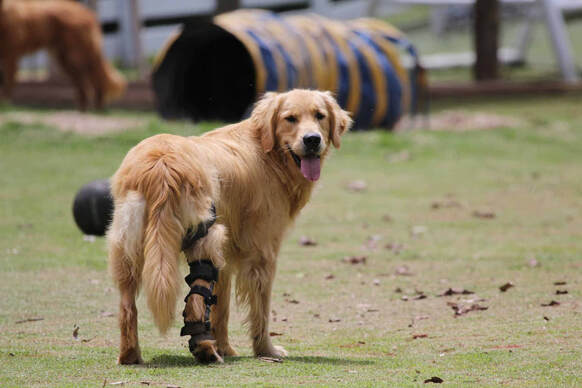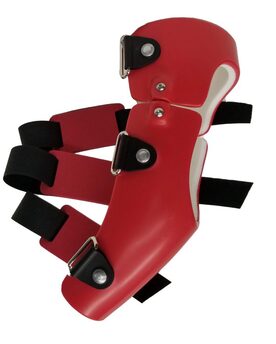A Comprehensive Analysis of the Use of Stifle Braces for Canines with CCL-Deficient Knees.2/28/2024 Canine CCL (cranial cruciate ligament) deficiency is a prevalent orthopaedic condition in dogs that can lead to discomfort, lameness, and altered gait patterns. The utilisation of stifle braces has gained attention as a potential treatment option for this condition. In this blog, we will look to examine the advantages and disadvantages of stifle braces in treating dogs with CCL-deficient knees, with a particular focus on the impact on gait patterns. The use of stifle braces in dogs with CCL-deficient knees has demonstrated promising results in terms of reducing lameness and improving joint stability. Stifle braces, which can be custom-fitted to the dog's leg, are designed to limit the movement of the joint, providing additional support and stabilisation. This can help alleviate the discomfort and pain associated with the condition and prevent further damage to the joint. However, the use of stifle braces is not without its drawbacks. One of the most significant concerns is the potential impact on gait patterns. Studies have shown that dogs may alter their walking patterns when wearing a brace, which can lead to muscle atrophy and reduced joint range of motion. Additionally, the long-term effects of using stifle braces are not yet fully understood. Understanding CCL Deficiency The CCL (cranial cruciate ligament) is a major ligament located in the knee joint of dogs. It is similar to the ACL (anterior cruciate ligament) in humans and is responsible for providing stability to the knee joint. The significance of this ligament can be understood by the fact that it prevents the tibia bone from sliding forward relative to the femur bone. However, this ligament is susceptible to damage or degeneration, which can lead to a condition called CCL deficiency. In this condition, the knee joint becomes unstable, causing pain and discomfort to the dog. Over time, this instability can lead to the development of osteoarthritis, which can further exacerbate the problem. Therefore, it is important to take timely measures to manage this condition to ensure the dog's well-being. Advantages of Stifle Braces Support and Stability Stifle braces support weakened knee ligaments and stabilise movement. They're light, breathable, and adjustable, recommended for knee injuries, arthritis, or unstable patellas. While they reduce pain and improve mobility, they're not a standalone solution and work best with physiotherapy and medication. Pain Relief Stifle braces stabilise joints and reduce pain in dogs with CCL deficiency. They enhance comfort, mobility, and quality of life. These braces are a viable therapy for managing CCL deficiency in dogs. Conservative Management Stifle braces are a non-surgical alternative for dogs with CCL deficiency. They stabilize the joint, reduce pain and inflammation, and promote healing. Stifle braces are suitable for dogs who can't undergo surgery due to age, health, or other conditions. They can be a good option for pet owners who prefer a conservative approach. With proper use, stifle braces can improve dogs' quality of life. Enhanced Healing A stifle brace can be useful for individuals with partial ligament tears. It helps maintain alignment, preventing further damage, and promoting natural healing. The brace supports the affected area, reducing injury risk and pain. Overall, it's a helpful aid in the healing process. Disadvantages of Stifle Braces Limited Efficacy Stifle braces may provide relief for CCL deficiency symptoms, but may not address the underlying cause. The braces' effectiveness depends on the severity of the condition and individual factors such as the dog's size and activity level. These factors should be considered before deciding on using stifle braces as a CCL deficiency treatment. Potential Discomfort Dogs with hind limb injuries may benefit from a stifle brace to support and heal their leg. However, some dogs may be uncomfortable wearing it, which can cause resistance. To ensure a successful recovery, work with a professional to properly fit and adjust the brace. Gradually increase wear time to help dogs adjust. Risk of Skin Irritation Stifle braces used to support the knee joint in animals can cause skin irritation or pressure ulcers due to extended use. Proper fitting and ventilation of the brace are essential to prevent the constant pressure on the skin that can cause redness, itching, and discomfort, which can worsen over time. Regular monitoring of the skin’s condition is necessary to prevent pressure ulcers, which are painful sores that form due to prolonged pressure on the skin. Cost Considerations When using stifle braces for knee injuries or conditions, high-quality braces are more expensive but provide better results in the long run. They prevent further damage or injury, making them a valuable investment. Choosing a durable brace will save money on maintenance and replacement costs compared to a cheaper option. Impact on Gait Patterns
The utilisation of stifle braces in dogs with CCL deficiency can have significant implications for their gait patterns, which play a crucial role in overall mobility and quality of life. Understanding these impacts is essential for assessing the effectiveness and suitability of braces as a treatment option. Initial Adjustment Period When first introduced to a stifle brace, dogs may exhibit alterations in their gait patterns as they acclimate to the device. This adjustment period is characterised by tentative steps, slight hesitations, and a cautious approach to movement. The added support and constraint provided by the brace can initially feel unfamiliar to the dog, prompting a period of adaptation. Altered Weight Distribution Stifle braces aim to stabilise the knee joint and compensate for ligament deficiency by redistributing weight-bearing forces. Consequently, dogs may exhibit changes in weight distribution across their limbs, favouring the unaffected leg to reduce strain on the injured one. This redistribution of weight can lead to observable differences in stride length and intensity of limb movement. Compensatory Mechanisms Dogs are remarkably adaptive creatures, capable of employing compensatory mechanisms to mitigate the effects of joint instability. When wearing a stifle brace, they may adjust their gait to minimise discomfort and maximise efficiency. This can include alterations in limb positioning, such as a slight outward rotation of the affected leg, or changes in the timing and coordination of steps to maintain balance and stability. Gradual Adaptation With consistent use and proper fitting, many dogs gradually adapt to wearing a stifle brace, demonstrating improved confidence and fluidity in their movement over time. As they become more accustomed to the device, gait abnormalities may diminish, and a more normalised walking pattern can emerge. This gradual adaptation underscores the importance of patient monitoring and ongoing adjustment of the brace to ensure optimal fit and comfort. Long-Term Effects While stifle braces may initially impact gait patterns, their long-term effects on locomotion can vary depending on factors such as the severity of CCL deficiency, the dog's age, and overall musculoskeletal health. In some cases, dogs may continue to exhibit subtle alterations in gait even with prolonged brace use, while others may demonstrate a return to near-normal movement patterns as joint stability improves and compensatory mechanisms become more refined. Monitoring and Adjustment Monitoring a dog's gait with a stifle brace is essential for evaluating its effectiveness and detecting any issues. Vet and rehabilitation professionals may adjust the brace or treatment plan based on the ongoing evaluation. Understanding the impact of stifle braces on dogs with CCL deficiency is crucial for optimal outcomes. By monitoring gait and addressing concerns, vets and pet owners can ensure the effective use of braces in a comprehensive management strategy. Stifle braces represent a valid option for the management of CCL deficiency in canines. The application of this medical device provides support, pain relief, and the potential for conservative treatment. Nevertheless, its employment presents both advantages and limitations and requires a thorough consideration of individual patient factors and owner preferences. Despite the potential impact on gait patterns, proper fitting and monitoring of the device can lead to increased comfort and mobility for many dogs. A balanced analysis of the advantages and limitations presented above enables veterinarians, rehabilitation specialists and pet owners to make informed decisions about the inclusion of stifle braces as part of a comprehensive treatment plan for CCL deficiency in dogs. If you want to learn more tricks and tips and be involved in a community of like-minded individuals, join our Facebook group at: |
AuthorJoanna Whitehead Archives
June 2024
Categories
All
|



 RSS Feed
RSS Feed
